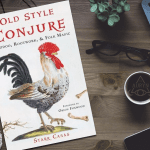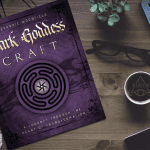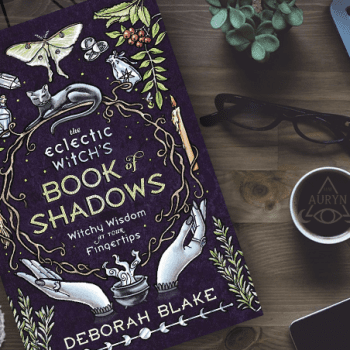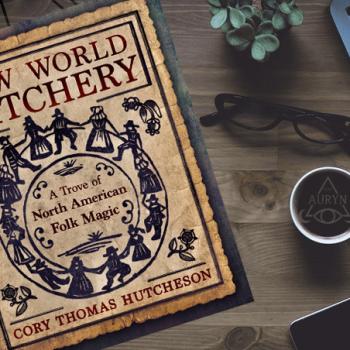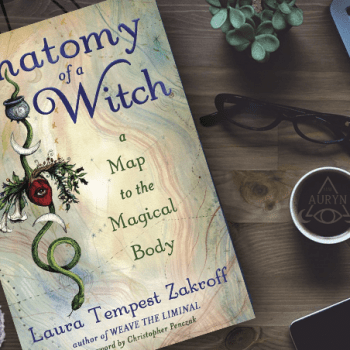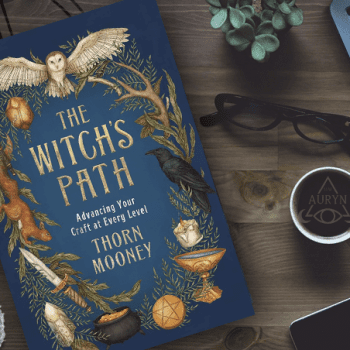Christopher Orapello is an artist, witch, and animist with a background in western occultism, ceremonial magick, Freemasonry and has been on his journey for over 20 years. He co-hosts the podcast Down at the Crossroads with his partner, Tara Maguire, and is a signature artist with Sacred Source (a leading producer and distributor of ancient deity images in North America), and an author with Red Wheel / Weiser Books with his first book coming out in the Fall of 2018. After a growing desire for a more locally based form of witchcraft, he and Tara founded Blacktree coven in 2014, where they set out to forge a modern approach to Traditional Witchcraft for a new era of praxis.
Tara-Love Maguire has been a practicing witch for over 30 years, on a path which has been crookedly influenced by Isobel Gowdie, Marie Laveau, and William S. Burroughs. Growing up in and around the New Jersey Pine Barrens, she found witchcraft within the tales and shadows of that folkloric landscape. She co-hosts the podcast, Down at the Crossroads with her sweetheart, Christopher Orapello, and is one of the founders of Blacktree Coven, which exists in the heart of southern New Jersey.
Down at the Crossroads is one of my favorite podcasts and both Chris and Tara have fantastic taste in books, people and witchery. On top of that, both of them are very down to earth and cool people. I wanted to learn a bit more about them and their work so I decided to see if they’d be up for an interview and they were cool enough to agree.
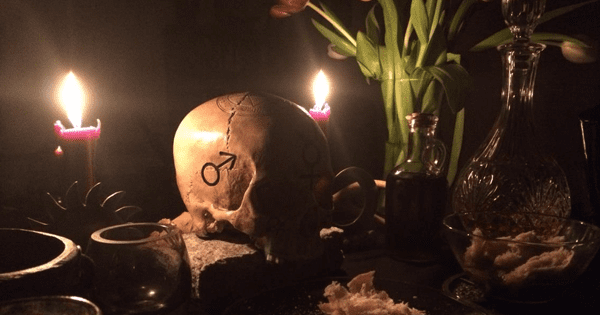
How did you discover witchcraft?
Chris: I first discovered witchcraft in 1991 -at the age of 14- when I stumbled upon the New Age section of a local bookstore. It was there that I found and purchased a copy of Earth, Air, Fire, & Water: More Techniques of Natural Magic by Scott Cunningham which I still have to this day, pages and all in a manner of speaking as it’s over twenty years old. I remember being amazed by the realization that magick and spells were real and not just something from a story, movie, or television show.
For a period of time, I did some of the workings from his book. I would go outside into the backyard after everyone in my family was asleep to cast spells, write bad teenage poetry, enjoy the night sky, and contemplate the mysteries of life to the best of my adolescent understandings.This was also slightly before the Wicca boom which happened in the late nineties after the release of The Craft (movie, 1996) and the start of Buffy the Vampire Slayer (TV, 1997) and Charmed (TV, 1998). Although Scott Cunningham’s book first exposed/primed me to magick, it was the movie The Craft which ignited my interest and fascination with it.
As a fictional depiction, the film showed me something of a deeper context for magick, like ritual and ceremony. I remember loving Lirio’s bookstore in the film and the field trip the four main characters took out of the city. The ritual they did and the vibe of it heavily resonated with me and reminded me of the time I was casting spells under the light of the moon only 5 years before.
In retrospect, Scott Cunningham’s book was probably the best introduction I could have had to magick because it didn’t necessarily contain any of the trappings of religion or a sense of formal ritual. This distinction would linger in the back of my mind the more I got exposed to Paganism and the general Western Mystery Tradition. I understood from the beginning that magick could exist and happen with the simplest of actions and didn’t entirely require tools, props, or a grandiose scripted production in order to be effective.
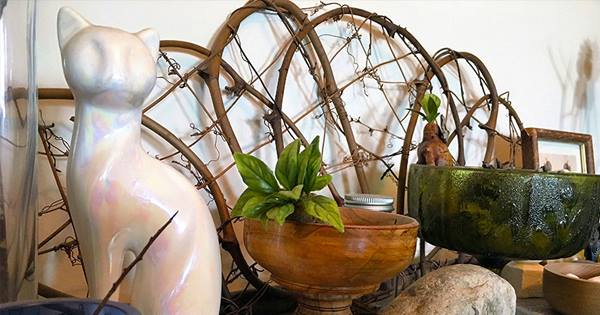
Tara: I feel like witchcraft has always been inside of me. I’ve been a practicing witch for approximately thirty years or so, though I’m always a little uncomfortable with that pronouncement because who starts really studying witchcraft at the age of ten? Like full on studying and comprehending of it? C’mon. But, it would be even wankier for me to make the statement, “I was born a witch”- even though that’s kind of what I feel.
At any rate- while growing up, I read books on different mythologies and lore, conducted mad rituals to honor obscure gods in my backyard and bedroom, danced in bedsheet robes stolen from the linen closet and concocted potions made from whatever swamp weeds I scrabbled in the dirt numerous attempts to smite my enemies. I watched the moon wax and wane, I listened to the voice of the rain, I sang hymns over dead kittens when I found them stricken cold, pretended I was a mermaid, and very rarely wore shoes if I could help it. Your typical feral child.
For all of my wildness, I also had a pretty bad book habit, even from a very young age. I was also quite ridden with Youngest Child Syndrome, so any question I had for my parents (and there were quite a number of questions, something I’ve never really lost the habit of) was met with a tired “Look it up.” We had an old Encyclopedia Britannica that was a point of strange pride for my mother, even though it was missing the R volume.
On days when I couldn’t wander outside, I would sit and read the encyclopedia, one volume after another. When I went to my father’s house on weekends, his Irish girlfriend had a giant box of old books in their hall closet, spilling full of fairy tales, not just of the Grimm variety, but also of the leave milk out for the piskies type. In short, I was your run-of-the-mill weird kid. We’re a dime a dozen, honestly. Nothing special.
I spent a long, long time trying to figure who and what I was. Thankfully, I was never forced into a spiritual box of any sort when I was growing up, so I never had to shake those trappings off before I could fly free. I only had to stop tripping over my own two feet.
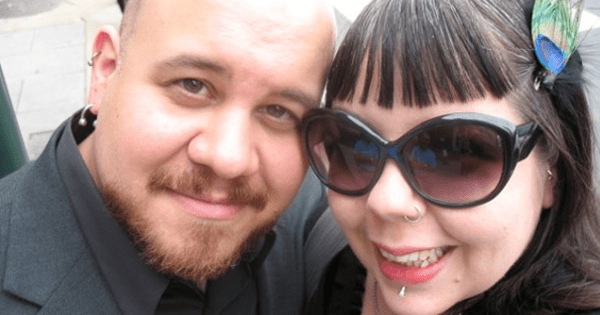
How did the two of you meet?
Tara: We met in 2001, though we argue about the month. I say late June/early July- he says late May/early June. At any rate, the year prior, I had torpedoed my marriage in a spectacular fashion, so I was sleeping on my mother’s couch in New Jersey, after having lived in Philadelphia for the past ten years. I needed money to get back on my feet, so I took a job at a mortgage company that my mother worked for. At the time, I was still a smoker and in my department, there was a woman who would go outside on cigarette breaks with me.
One day, she says to me that if I ever noticed her necklace outside of her shirt, to let her know. Essentially, this was her way of signaling to me that she was a witch (it was a pentacle necklace) and that she felt I was either also a witch or at the very least – witch friendly, since I was one of those goth weirdos who dressed in Victorian drag for everyday work (those elaborate clothing and make-up days are long gone, now I dress like some demented Baba Yaga).
So, this woman and I develop a type of friendship and at one point, she tells me about this study/social group thing she goes to for all different types of pagan-ish people- the Marlton Witches’ Coalition. And she says the guy running it, he and I would get along really well. At the time, I was in a relationship, but more friends are always cool, right? So I agree to go to a meeting with her at the bookstore they were held in, but she also gives me the AOL screenname of the group facilitator.
I look-up his webpage and it has his senior college project on there which were these fantastical, Hellraiser-sequences jewelry pieces- just gigantic and made out of metal and looking like they could ruin someone. I thought these were just beyond beyond, so I message the guy to tell him so. My work friend had already told him about me, so he knew who I was and we started talking, and then hanging out. My previous relationship goes on to meet its eventual demise (which was already in motion beforehand anyway) and this guy (who I’m assuming you’ve all figured out is Chris, if not- SPOILER ALERT) and I just never really stop hanging out. Sixteen years later, we’re still hanging out and somehow haven’t killed one another in that time. He consistently makes me laugh myself stupid, so I guess I’ll stick around.
Chris: *grins*
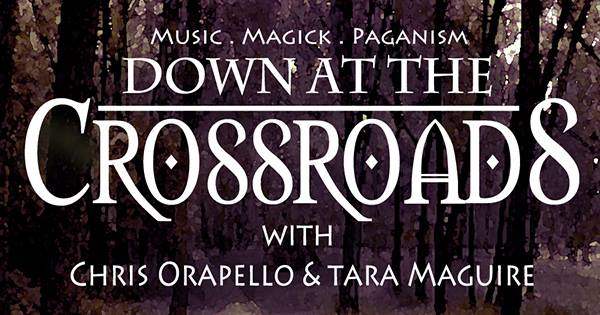
What inspired you to start the podcast?
Chris: I started the show because I wanted to share information and entertain people. Despite being the host and producer, I actually had no interest in being the center of attention. I think some people who start podcasting do so to get attention and to make themselves into something, that wasn’t my goal. I wanted to have fun, explore, incite people’s curiosity, as well as challenge and entertain them while doing it.
Like many podcasters, I was a listener at first. There were several shows I followed which no longer exist (Haunted NJ, Hometown Tales, Thelema Coast to Coast, and deo’s Shadow) and at some point in late 2008 something in my head got switched on and the idea to do my own show began rolling around in my brain. It felt like something awakened in me, because podcasting became a part of who I was before I ever started recording. Before I realized it, I was planning, plotting, designing website graphics, etc. It just felt like this was something that I was meant to do.
I knew I could do it at least as well as the shows I had been listening to. Having organized a group in the past, with presenting material and creating content, I knew that I had plenty of things to say about a variety of topics. I knew I could carry a show and thankfully other people thought so too! *laughs* So, in January of 2009 I started producing The Infinite and the Beyond (TI&TB) which was an entirely scripted and segmented show, which required a lot of research and recording. I learned as I went. Made mistakes. Refined my approach. I actually recorded the first episode twice to get a feel for it.
Episodes for Ti&TB were released roughly every 6-8 weeks, but the more complicated the format got, the tougher it became to formulate and produce each episode as they began to develop unique themes within them, a hidden thread which went through each episode, tying all the segments together. It got difficult. I pretty much painted myself into a corner with the format, which even grew to include interviews with other people. Something had to budge and after doing TI&TB for 4.5 years (32 episodes), I decided to reformat the show because I didn’t want to stop podcasting, I just needed a change.
So, in August of 2013- I started producing Down at the Crossroads (DatC) which focused on interviews and music from independent artists who I enjoyed. As the producer, I always used myself as a content filter to help the show maintain a consistent level of quality. If it intrigued me, made me smile or laugh, then it worked for the show as far as I was concerned.
Starting the podcast has definitely been a life changing endeavor for me. It opened doors in my life and work where they were otherwise closed. It was clear where I needed to be heading and I haven’t looked back since. Blogging, being interviewed, presenting at events, working with FaerieCon, making art, selling sculpture and ritual tools online, becoming a signature artist with Sacred Source, and now an author with Red Wheel / Weiser Books. I never would have anticipated any of this happening back in 2008. Not to sound cliché, but it’s all a dream come true.
How has the podcast evolved since its inception?
Chris: It’s amazing how the show continues to grow even now. What first started out as a hobby has become a part time job in many ways in time and service to the Pagan community as a whole, and the community we have developed around the podcast over the years. The show has affected so many people’s lives and paths in the 8.5 years since its inception, that we know we can never stop being a part of that. The show -as an entity- has transcended itself in many ways, which is something I never thought could happen.
It’s no longer just a thing I do, it’s something I’m a part of. It’s something that we are a part of because Tara, after many years, has finally been drawn into the show. And I say ‘drawn into’ because it was something she never was sure about being a part of. I, however, knew that she was exactly what the show needed. A strong, intelligent, woman to balance my statements and to talk about things in a way that I couldn’t and consequently had no right to talk about, but which needed to be said.
The most recent evolution of the podcast was the establishment of our Patreon Page to help the show have an independent financial backing to it and echo the role it has played in the lives of others. In return to the support it receives, patrons of the show get access to SWAG and perks like additional content, contests, and prizes.
Tara: Yeah, I never really wanted to be on the show. One, it was his thing and I try really hard to make sure we both have our own things- we’re not a homogenous unit, we’re individual people, so we both need to have something that doesn’t involve the other. Just for sanity’s sake. And two, I’m a precious, delicate flower who craves attention, but hates when I actually get it.
I started listening in on certain episodes and you can occasionally hear me laughing in the background on some of them, the second Sarah Anne Lawless episode, I’m in the background giggling. And I think the second or third Byron Ballard episode. At one point, when we started to be friends with some of the guests, I would actually be part of the interviews. Chris eventually said to me that I needed to make a decision about whether I wanted to be officially on the show and I grumbled a lot, but ultimately decided I would be a regular presence and so- here we are.
It can be overwhelming sometimes, when I think too much about the actual presence and genuine reach the show apparently has- how many downloads it gets on a consistent basis. It makes me want to hide under the bed! But, we sometimes have people come up to us at pagan/witchcraft/occult events and tell us how thankful they are to have the show because it makes them feel not so alone or that they learn things from us or we put into words the things they’re thinking and feeling. And it really puts things into perspective for me. We’ve also made some amazing friends along the way because of the show that we are very close to. I wouldn’t trade it for anything, this opportunity and ability to impact other people. And additionally have them impact us. It’s just wonderful.
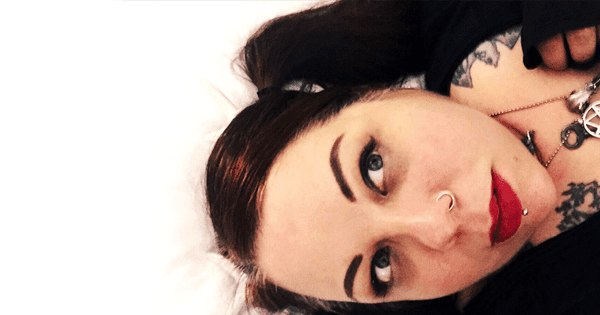
What are some of your favorite memories from the podcast?
Tara: After the second Sarah Anne Lawless episode, we stayed on the line and wound up Skype-ing with her afterwards for about five hours- just talking about witchcraft and bones and plants and life. Huge amounts of stuff. It was SO much fun. I wish we were doing the Patreon After Parties back then, because people would have lost their minds over it.
Chris: I still can’t believe we chatted with Sarah that long afterwards, but we really did. It was great. There’s a lot of things about doing the show I could bring up in response to this. The funny spontaneous moments in the show I created while recording, like licking a frog in episode #13 and tripping balls, making a Star Trek reference in episode #26, the crazy openings I’ve done like the New World Order infiltrating the show as a precursor to discussing conspiracy theories in episode #21, or my computer becoming a character in episode #27 to play off the idea of free will.
I even learned a tremendous amount of things researching for the show and figuring out my own thoughts and opinions as I went along. It caused me to have a lot of personal revelations and the show became extremely personal because of that. And finally there’s the interviews! I’ve met so many wonderful people as a result of the doing the show. There’s nothing quite like sitting down to speak one on one with a complete stranger in the beginning and finding a friend as a result. It’s been a blast.
Tara: Chris has never actually licked a frog, mind you.
Chris: Says you! I am a frog licking fiend, I’ll have you know.
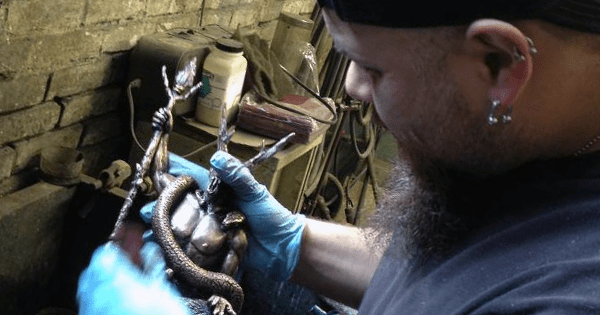
Your statues the Witch Lord and the Witch Queen are absolutely stunning. One thing that strikes me is how many different deity references that you can see in just one statue. Yet, I feel like you’ve really captured the essence of the main dual deities of most witches. Can you discuss a bit of the archetypal images that you worked into these statues? Was this based on a preconceived vision or did it sort of create itself as you worked on it?
Chris: Thank you. I’m glad you think so! As some could tell, the base component of inspiration for both images was Eliphas Levi’s illustration of Baphomet. In a sense the Witch Lord and Witch Queen were pulled out of Baphomet to make two separate images which were then individually combined with related deities and other symbols and tools. Herne, Cernunnos, Pan, Buccadhu served as additional inspiration for the Witch Lord. Ishtar, Lilith, the Morrigan, Hecate, Kali, and Cerridwen served as additional points of inspiration for the Witch Queen.
As far as the sculpting process, The image of the Witch Lord came to me in its entirety all at once, but the image for the Witch Queen was much more difficult to find. There was a lot of trial and error, journey work, and meditation to find her image and even then I suffered some casualties along the way with her. Because something went drastically wrong with the first mold that I took of her clay original. I had to basically sculpt her a second time from a shoddy single wax cast I was able to make from that initial faulty mold. Nine months of work on her was almost lost completely as a result of the mold!
I wondered if I needed to make additional offerings or do something to appease her. *laughs* I made the resculpting of her an act of devotion and I talked to her constantly as I worked. Thankfully she permitted me to succeed at producing her image for which I am grateful because I honestly had doubts as to whether or not she wanted to be depicted or produced. I even came up with a simple chant for her that I would say while working on her to show my respect.
“Ishtar, Lilith, Morrigan
Hecate, Kali, Cerridwen”
Like I said, simple. *laughs* I personally enjoy the mysteries which these pieces reveal and teach to those who study them individually and in contrast to each other. There’s a lot to be gained from them. It’s interesting, as the sculptor I think that my greatest success about them is that they don’t feel as if I made them. I’m just thrilled that they have been so well received.
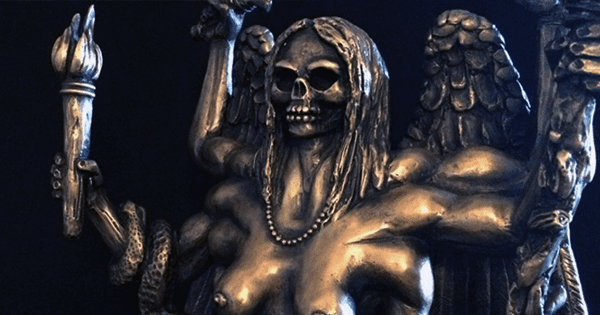
What is so great about them is they seem to be in stark contrast to the more common images of deities that have them modeled a bit more in the form of society’s beauty standards of perfection. Possibly since a lot of these statues come from major pagan religions of the past instead of the outsider witch-cults. These two seem so much older, much more wild and darker and you can almost feel the power of their essence that you’ve captured. Often we find a sanitization and a domestication to these two, instead of something that feels almost dangerous at first approach, like their power hasn’t been “defanged”. How does this reflect your view and relationship with the gods of the witches?
Chris: I think they are the most accurate depiction of them in concept, at least as far as my work as an artist and witch is concerned. I think the images themselves are not necessarily the thing which they are depicting, if that makes sense? They are an abstract means to understanding that which they represent.
In my own work, the Witch Lord represents the wildness of nature and the land which includes death and decay and all the horrors that get ignored in picturesque sunsets, fields of flowers, or the generic depictions of scenic beauty which can be found in calendars, office spaces, and tourist marketing commercials. Nature is nature’s friend. Nature is not our friend. We need it, but it doesn’t need us, that’s for sure. So in that respect the Witch Lord is not a friend, but should be approached with respect and the same fear and concern one would have for a rattlesnake or any wild animal.
The Witch Queen is a more about the totality of life, death, the cosmos, the above and the below. Like the Witch Lord, she too represents the duality that is inherent in those things and not just the happy beautiful parts. She is just as much about chaos and destruction as she is about regeneration and rebirth. She was also intended to be monstrous, as like you pointed out, too many representations of deities in modern pagan culture are entirely wholesome and safe which is often disingenuous to their nature and what they represent. We’ll know when we’ve jumped the shark as a culture when we start seeing the equivalent to a “Precious Moments collection” of Pagan deities on the market. Please Gods no!
I think the loving and adoring mother and father images of deity is a carry over from a lot of the ideas of deity which many of us were brought to believe in and identify with which I think are inaccurate. Nature is cruel and loving as well as beautiful and disgusting. It’s not either/or.
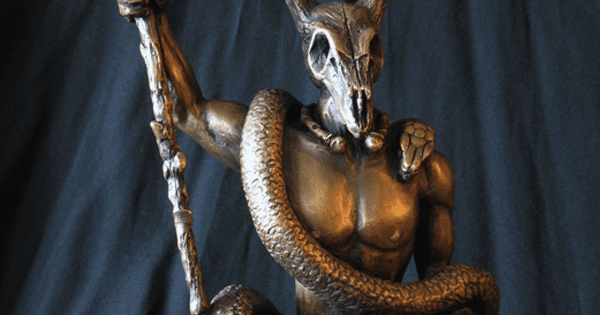
They’re about to be mass-produced, correct?
Chris: Yes. The Witch Lord is actually currently available in cold cast bronze through Sacred Source and is even on the front cover of their 2017 catalog, which also makes up the back cover of Witches & Pagans magazine. So, I feel quite fortunate in that regard. The Witch Queen is currently in process and should be available from them sometime this year. I’m so happy to be working with them and I have the full intention of producing more pieces through them. Some of which I’m in the middle of sculpting, along with everything else I’m doing! *laughs* It’s great as a sculptor to be working with a company like Sacred Source. I can just create art knowing that I have a way to get it to the world, which is such a blessing in itself.
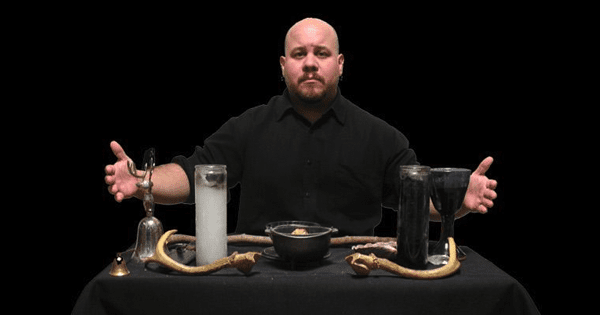
You both founded your own tradition of witchcraft, The Blacktree Tradition, which states that it’s influenced by pre-Wiccan traditions of witchcraft. What are your witchcraft and occult tradition backgrounds and what has influenced your tradition?
Tara: It should be noted that we don’t claim to be “pre-Wiccan” witchcraft, we just make the clarifier of being “non-Wiccan”. With that said, I started out as just kind of a swamp witch. I never had that Wiccan introduction that so many modern witches of my age wax nostalgic about. Growing up, I read a lot of folklore and fairy tales and mythologies, so the spells and workings I developed usually came from ideas I found therein. And since my family moved around a lot, I never really had all that much time to forge lasting friendships, so I also wound up spending a lot of time in the woods just by myself. Every chance I got, I would go into the woods and spend as many hours as I could there, feeling the land around me and talking to things which weren’t there, sometimes just letting my mind drift and gather visions as I watched the pattern of shadows from the sun coming through the trees. I was pretty much feral.
Feral children generally aren’t given too much schooling on Jesus, so I wasn’t brought up in any particular religion and never had much of a connection to “God”, so I’ve never been entirely comfortable with any type of deity work as a witch. I’ve generally shied away from any particular pantheon, although when I was in high school and into my early twenties, I decided it was something I was supposed to have, so I somehow forged a shaky relationship with Brigit (I was obsessed with the Celtic myths at the time and she seemed as good a choice as any). I was never really quite sure what to do with her and I don’t think she ever really knew what to do with me, either. I was spectacularly bad at it and in my mid-twenties, I gradually started to lose connection with her until one day, it was completely gone. This threw me severely off my footing and I stumbled around a lot.
At one point, I got heavily into the mystic side of William S. Burroughs (still am) and thus- Chaos magick. The idea of paradigm shifting appealed greatly to my magpie brain and merged nicely, I thought, with Burroughs’ cut-up work and the Dream Machine that he developed with Brion Gysin and Ian Sommerville, which I always felt was fantastic for journeywork. Chaos magick ultimately led me to Haitian Vodou, which I practiced for about thirteen years. For a variety of reasons, the greatest of which was the sense of an overwhelmingly arrogant appropriation on my part, I have stopped calling myself a vodouisant- although I still work with several lwa I have maintained tight relationships with.
All throughout this time, I remained just the same swamp witch. No matter what path I was on, I still had this dirty magick I could rely on to never leave me. I didn’t need a connection with any of the gods or a particular cultural association, it was just there. I started focusing more on that instead of trying to find some pantheon to align myself with and I began to read a lot about the different currents of traditional witchcraft. Around that same time, Chris was going through his own changes and we made the decision to start practicing together- something which ultimately became the Blacktree tradition. It’s a perfect merging of our occult backgrounds and influences, I feel.
Chris: A lot of my background is rooted in more lodge-based, ceremonial, and high magick systems such as Freemasonry, Hermetic Order of the Golden Dawn, and grimoire based systems in general, but I love witchcraft and the shamanic direction it has taken over the recent years by the reemergence of Traditional Witchcraft and the influences of Robert Cochrane and others.
As a practitioner, I’ve wandered a lot between various schools of thought, traditions, and systems, but I wouldn’t call myself a collector of titles or degrees in any sense. Primarily because I don’t have very many degrees *laughs* and I’ve actually turned down more initiations than I’ve taken which only include Freemasonry and Gardnerian Wicca, which I was only formally involved with for a brief period of time. Even then a lot of what have I learned over the years has mostly been from reading and practicing on my own.
After being exposed to so many different systems, the similarities became so noticeably interchangeable to me that when I thought I was being exposed to something new, it was really just unfortunately more of the same. I began to suspect that -to quote Gordon White from a interview I did with him- I had made it to the end of the salad bar.
I realized that because my path had been so wide for so long -exposing me to so many things under the proverbial Western Esoteric Sun- that it was either follow in the footsteps of others and risk learning very little -doing what has been done so many times before- or embark on doing my own thing. So, Tara and I began practicing together after 13 years of being on very different paths and we decided to shed it all. Having nearly 60 years of combined experience between us we built our craft from the ground up, keeping what we wanted and discarding the rest. The Blacktree Tradition is the result of that
Tara: Also, not a huge focus on deities. No Gods, Many Spirits! It’s largely about one’s connection with the land they are currently on and the spirits who reside there. It takes my backwoods low magick and chaote influences and combines them with Chris more high-styled practice.
What makes your tradition of witchcraft unique compared to those influences?
Chris: Blacktree is a system of Traditional Witchcraft and is very non-Wiccan just for clarity sake and not to be condescending in any way. Let’s be honest, Wicca is a very loaded word and very much associated with any idea of modern witchcraft. After all, we wouldn’t be doing what we are doing if it wasn’t for Wicca, but the reality of the situation is that because Wicca was the first publicized form of modern witchcraft, when anyone hears the word “witch” by default they also think “Wicca”. So, saying that we are non-Wiccan is just the easiest and quickest way to address that there is a primary difference in what we do as a tradition and system of practice as we are not a religion or fertility-based cult.
We don’t follow the Wheel of the Year and I wouldn’t even say that what we do is an earth-centered practice in the neo-Pagan sense. Blacktree is a personal spiritual system. There is no worship or communing with deity or harvest-based metaphors at play. We’ll work with the Witch Lord and the Witch Queen as spiritual and magickal allies, but not as divine beings or parents. We don’t think of ourselves as priests or priestesses, because the tradition itself is non-religious.
Blacktree defines witchcraft as a practice of sovereignty, which is composed of six-paths. It’s also a purely animistic system, dealing with the spirits of the land and the ancestors. We don’t specifically work with any deities or rely on ancient pantheons from distant cultures. The tradition is 100% focused on where one lives and is expected to adapt and change if one were to relocate.
It’s also structured very loosely, meaning there is a built-in foundation which allows it to adapt to other systems quite easily, if that is what one desires. It is also not a blatantly elemental system, however the elements are there as underlying foundational components, in case they are needed for symbolic reasons, but one wouldn’t know that otherwise as we do not call air from the east, fire from the south, etc. We’re not very much into that.
As far as our ritual goes, there is a prescribed order and layout to the space, which feeds into the mystery component of the tradition which is where a lot of my background comes into play. However, despite any of the formalities that one may see in what we do, rituals are focused on fulfilling the needs of the witch and so can be altered and compromised extremely easily. One ritual is compiled of short smaller rituals which can be combined or ignored as the situation requires. Spontaneity is a very beneficial aspect to what we do.
Many of the differences in Blacktree are rooted in our approach to ritual and the world. An outsider may think it’s just more of the same, but there’s actually something different there when you get into it. I think that’s often the case with those who make the argument that Traditional Witchcraft and Wicca are the same thing. They’re not. One isn’t better than the other, but they are completely different entities.
Traditional Witchcraft is far more shamanic at its center while Wicca is far more ceremonial, but you won’t see that difference unless you dive in headfirst. And honestly, their methodologies and ideologies are different enough that I don’t even think they’re interchangeable, which is great. Something different is a good thing! There’s room for everyone in the pool. Our book goes into these differences as it is very Blacktree-centric and is meant to give someone a solid foundation on what we do as a tradition and coven.
Is there a title or working title for the book yet? When can we expect it?
Tara: I am ridiculously in love with the book title and can’t wait until we can start referring to the book publicly by name!
Chris: There is a current working title for the book and subtitle, but since I experienced a theft online in the past in regards to the Witch Lord who was poorly copied by a seller on eBay several years ago, I’m more cautious with what I share online in regards to anything I do. So, with that said, we’re keeping the title secret until we get closer to the release date.
We are thrilled to say that our book will be coming out through Red Wheel / Weiser Books sometime during Fall 2018. At the moment we are in the final phases of the first draft, writing and drawing -I’m doing the illustrations- has become extremely time consuming to say the least.
EDIT: Chris & Tara invited me on Down at the Crossroads. Check out the interview here.
Ways To Support My Work:







